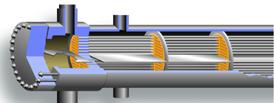Rapid
Tube Inspection
using
Eddy Current (ET) or Remote Field (RFT)
methods
(Download
Brochure, 164Kb)
Rapid
Non Destructive (NDT) inspection of tubes can be performed
using electromagnetic (Eddy Current, ET or Remote Field,
RFT) methods applicable to a variety of tubing applications
such as heat exchangers, furnaces etc in various types of
industries. Typically it provides graded tube layout
depending on the total percentage loss of material on each
tube wall and the results are color coded for easy
reference. The technique used depends on the tube material.
Non-ferromagnetic (with ET)
 On
non-ferromagnetic tubes the Eddy Current (ET) method is used
by inserting an EC probe from one end of the tube and
mechanically moving it along the entire tube length. The
method inspects the straight section of the tube and
provides results as percentage of total tube material loss
(e.g. 20-40%, 40-60% etc) per tube. It is capable of finding
general or local material loss, pitting, cracking and dents
on the inspected tube area.
On
non-ferromagnetic tubes the Eddy Current (ET) method is used
by inserting an EC probe from one end of the tube and
mechanically moving it along the entire tube length. The
method inspects the straight section of the tube and
provides results as percentage of total tube material loss
(e.g. 20-40%, 40-60% etc) per tube. It is capable of finding
general or local material loss, pitting, cracking and dents
on the inspected tube area.

Reporting method with color coding for material loss.
Characteristics of the ET technique
-
High speed method. Inspects 500-800, 10m tubes per day.
-
100% inspection of the tube.
-
Little surface preparation (cleaning).
-
Color coded reporting for convenient results overview.
Ferromagnetic (with RFT)
 On
ferromagnetic tubes the Remote Field (RFT) method is used by
inserting an RFT probe from one end of the tube and
mechanically moving it along the entire tube length. The
method inspects the straight section of the tube and
provides results as percentage of total tube material loss
(e.g. 20-40%, 40-60% etc) per tube. It is capable of finding
general or local material loss and cracking on the inspected
tube area. It is not suitable for finding pitting.
On
ferromagnetic tubes the Remote Field (RFT) method is used by
inserting an RFT probe from one end of the tube and
mechanically moving it along the entire tube length. The
method inspects the straight section of the tube and
provides results as percentage of total tube material loss
(e.g. 20-40%, 40-60% etc) per tube. It is capable of finding
general or local material loss and cracking on the inspected
tube area. It is not suitable for finding pitting.
Characteristics of the RFT technique
-
High speed method. Inspects about 200, 10m tubes per day
depending on frequency.
-
100% inspection of the tube.
-
Little surface preparation (cleaning).
-
Color-coded reporting for convenient results overview.
Additionally, both methods provide permanent inspection data
recording and storage for future reference. Within the
framework of Envirocoustics’ quality control system, apart
from the quality control documents, test data integrity is
assured and data records and complete technical reports are
provided.

Typical tube inspection system

Cut-out view of tubing and baffle plates.
Envirocoustics also provides
automated UT tube
inspection services and Eddy Currents welds inspection
services.